Brief

Executive Summary
- Southeast Asia will feel the effects of the next global downturn, albeit to a varying extent in each country.
- Compared with the global financial crisis of 2007 to 2009, when Southeast Asia’s annual GDP growth dropped from more than 6% to 2%, the region is more vulnerable. Economic growth rates are lower, the current account balance is lower because of a decline in net trade, the region is exposed to slower growth in China and commodity prices have dropped.
- Preparing now enables companies in the region to gain market share and accelerate: Winners pulled away from losers during the last downturn and widened the profit gap during the subsequent expansion.
- The winners excelled in four areas: a focus on cost productivity, tight balance sheet management, selective reinvestment for commercial growth and proactive M&A.
With many business leaders across Southeast Asia watching for indicators of a downturn, should the region be considered special? Yes, but not in the way that many believe. The region’s strong economic growth does not, in fact, shelter it from harm should other parts of the world sink into a downturn or even a recession.
True, the region—and we include the 10 countries comprising the Association of Southeast Asian Nations (Asean)—has not felt the effects of recent global recessions as severely as other regions have. Southeast Asia did not technically slide into recession during 2007 to 2009, but instead experienced a slowing of annual real GDP growth from 6.7% to 2%. Its recovery after the slowdown also exceeded that of most other regions (see Figure 1).
Southeast Asia usually follows global growth trends, but the region did not technically experience a recession during the Great Recession

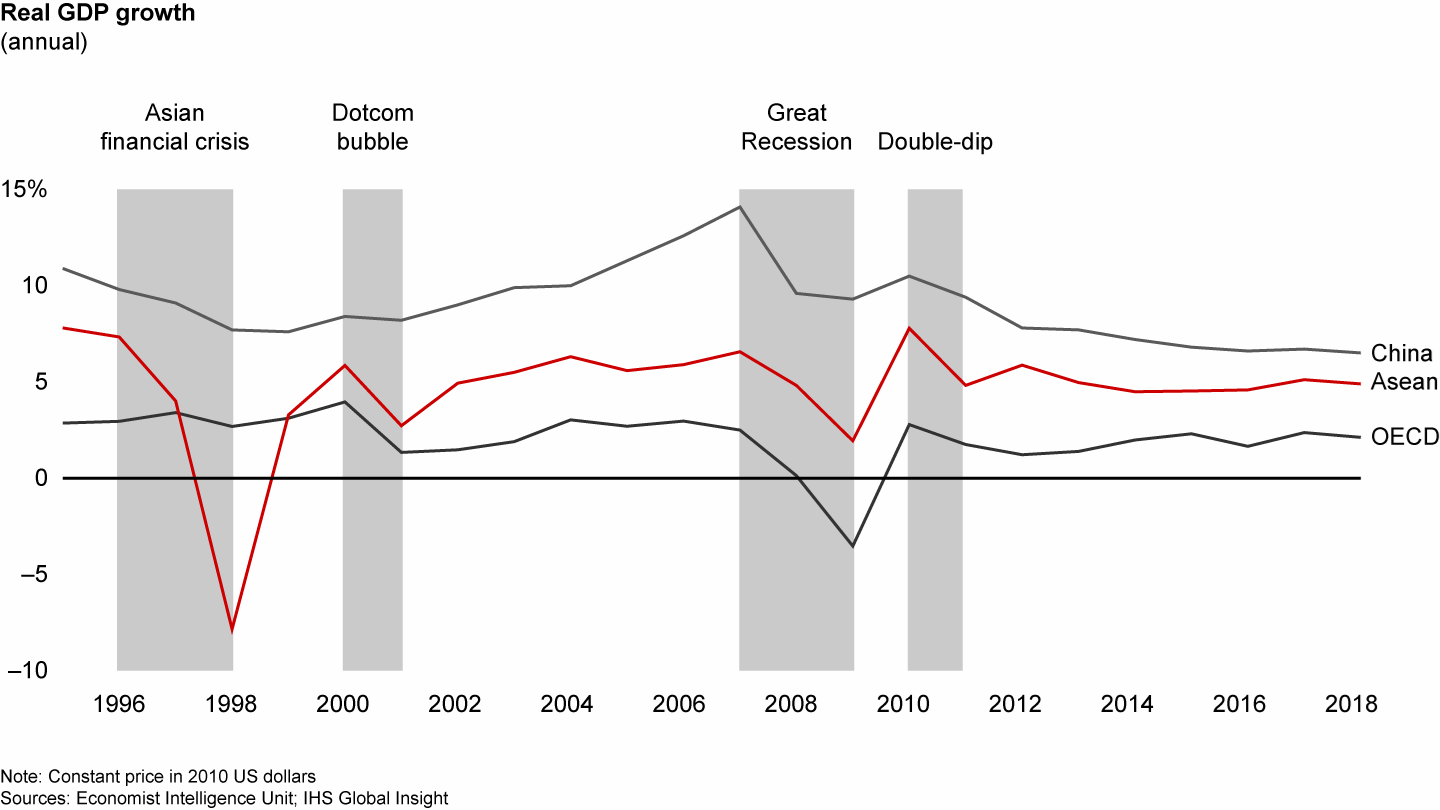
This does not mean, however, that Southeast Asia is decoupled from the rest of the world. To the contrary, several factors ensure that it will feel the effect of the next global downturn. First, it relies substantially on exports to other countries, notably the US, Europe and China. Second, much of its current growth is financed by capital flows from outside the region. And third, many of the structural traits that cushioned the region a decade ago, such as China’s strong growth and the global demand for commodities, now offer less of a buffer.
The shape of a downturn throughout the region could vary depending on the severity and causes of a global recession in those countries that buy large amounts of the region’s palm oil, coal, computers and other goods. Individual companies and even entire industries could feel deeper pain based on their exposure to other regions, sectors or commodity prices. Or companies could turn an imminent slowdown to their advantage by preparing properly now. For business leaders, then, the critical action is getting ready to seize the moment early, when they have more options. By taking a “future back” approach to what they want their company to look like in 5 to 10 years, they can actually use the downturn as an opportunity to achieve that future growth through more efficient operations and selective investments when asset prices and borrowing costs are lower.
Downturns rearrange the board
Bain & Company research finds that well-prepared Southeast Asian companies emerged as winners during and after past downturns. They managed strong defense and offense in parallel, focusing on raising their cost productivity to become more efficient even as they invested in growth.
Headed into the global financial crisis a decade ago, a group of 200 public Southeast Asian companies run through Bain’s “sustained value creators” analysis posted double-digit earnings growth, on average. As soon as the storm hit, performance diverged sharply: The winners, on average, realized a compound annual growth rate (CAGR) of 20% from 2007 through 2009 and 26% from 2009 through 2012. That performance stands in stark contrast to the losers, which had a 2% CAGR in the first period and 12% in the second. What’s more, winners locked in gains to grow at an average of 7% from 2012 through 2017, while the losers slipped at negative 3% (see Figure 2). A similar pattern of divergence occurred globally in our study of almost 3,900 companies, though in some regions the losers’ earnings actually shrunk during the recession. There is every reason to expect a similar divergence between winners and losers in Southeast Asia come the next downturn. To understand why, let’s quickly review the economic dependencies and risks.
Winning companies in Southeast Asia accelerated profitability during and after the recession, while losers stalled

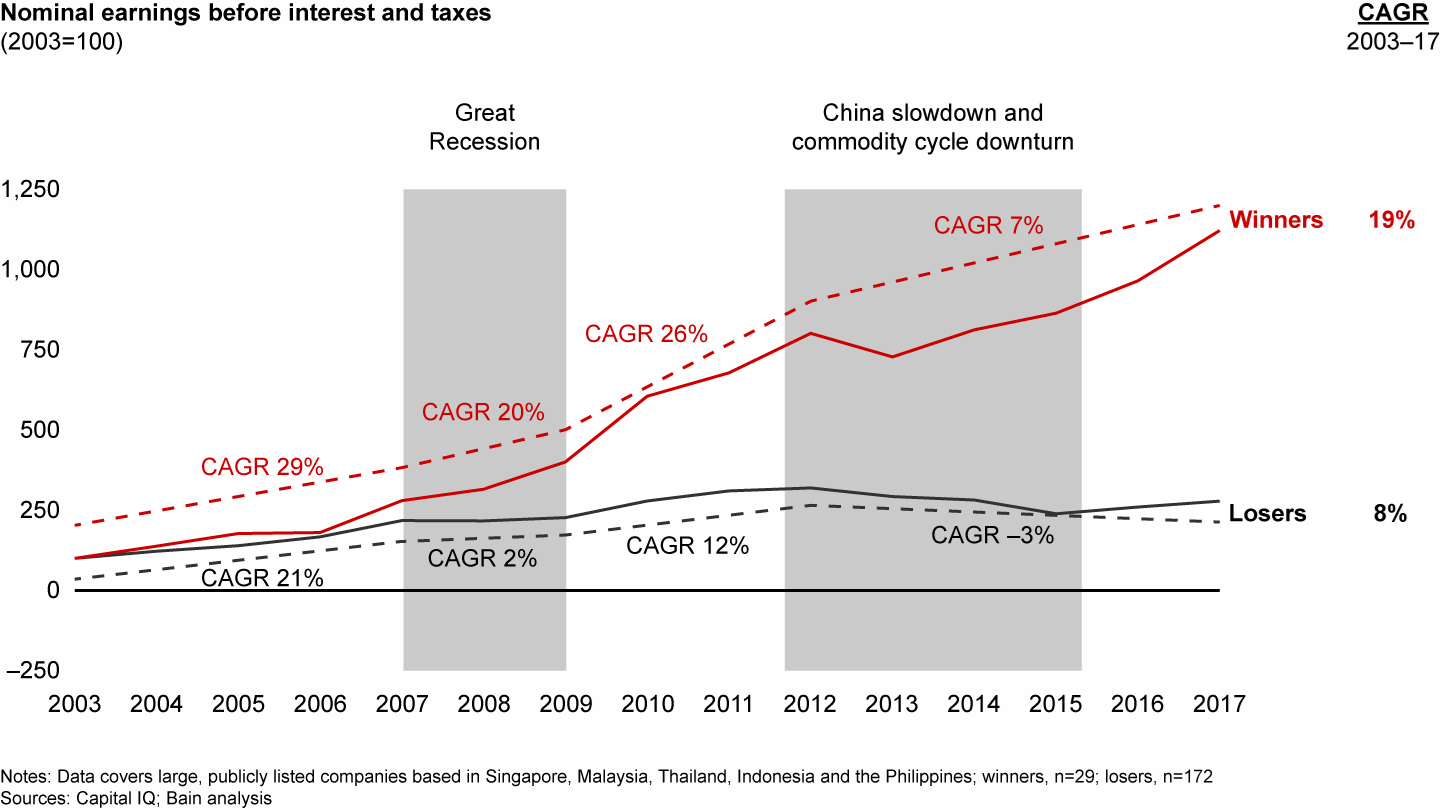
GDP growth throughout the region has strongly correlated with global trends (except for the Asian financial crisis in 1997). During the last global recession from 2007 through 2009, this trade-dependent region saw the value of exports drop by a 5% CAGR and the volume drop by 4%. Computers and electronics, basic metals, coke and refined petroleum, and chemicals were hit especially hard. Disposable income fell between 3% to 5% in most countries in 2009, resulting in a decline in consumption of 4% to 6% in those countries. Manufacturing posted virtually no growth in value from 2007 through 2009, while imports declined at a 5% CAGR. Current accounts (representing a country's net income over a period of time), which had been in reasonable surplus in most countries, fell widely and put some countries into a deficit.
Today, global economic and political situations suggest that a downturn is overdue after a decade of expansion, though the timing is, of course, unknowable. GDP growth has slowed in many regions, including China, where it fell from 12.7% in 2006 to 6.6% in 2018, the Economist Intelligence Unit estimates. Government, corporate and private debt have reached historic highs. Political conflict has put international trade at greater risk.
Despite these signs, many senior executives in Southeast Asia have not begun to prepare seriously for a downturn. Bain’s recent survey of more than 40 CEOs and CFOs in Southeast Asia found that 70% of them expect a medium downturn and 8% a severe downturn in the region within the next two years. Yet only 39% expect a downturn will have a severe or medium effect on their own company. Very few, 21%, have significant actions or plans in place; most have a light plan or no plan. Our conversations with them suggest that some are loath to even think about cost programs while they are growing, or they have never weathered a downturn as senior executives. Others are overly optimistic or believe they have time to wait.
How Southeast Asia is different today
These executives may not recognize how the region has become more vulnerable relative to its position during the last global recession. Several structural shifts stand out that raise risks for the region (see Figure 3).
Five structural shifts leave Southeast Asia more vulnerable than it was during the global financial crisis

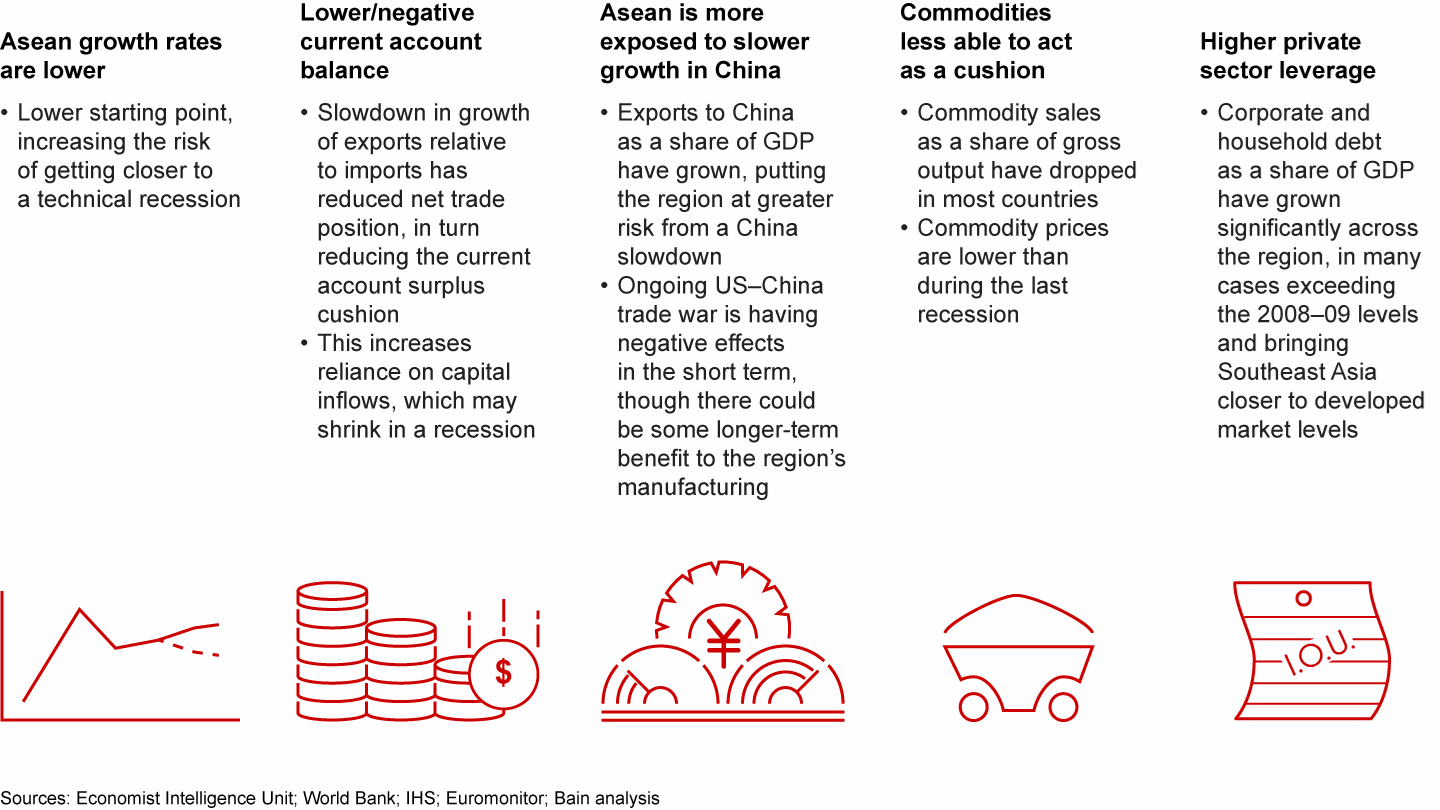
- Economic growth rates are lower this time in 8 of the 10 countries, dropping between 0.3 percentage points and 6.4 percentage points. Only Vietnam and the Philippines buck this trend (see Figure 4).
Growth rates are lower this time around for 8 of 10 Asean countries

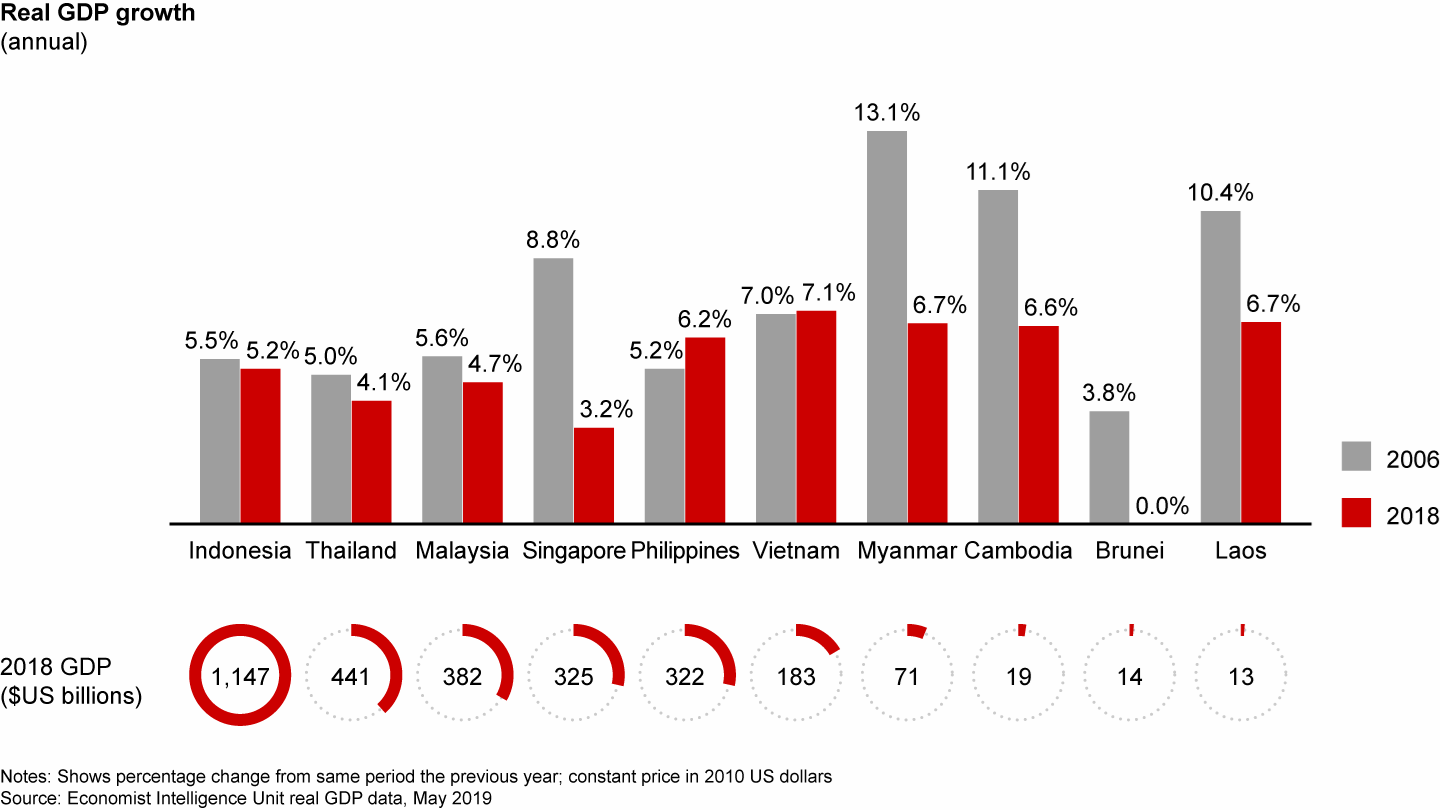
- Current account balances have dropped, shifting 5 of the 10 countries into a deficit, as exports have declined as a share of GDP, increasing the reliance on capital inflows.
- With a 5 percentage point increase in Southeast Asia’s share of exports to China since 2006, the region is more exposed to that country, where growth has almost halved. An ongoing US–China trade war might further slow China’s growth, which would pose a problem for the region in the short term. Longer term, it’s worth noting that a trade war could benefit Southeast Asia by, for instance, accelerating a shift in manufacturing to Vietnam or raising Chinese demand for Thai food products.
- Commodities’ contribution to the region’s GDP has dropped across markets from 23% to 18%, and prices could fall further. For instance, the MSCI Global Soft Commodities Index fell from 221 in May 2009 to 169 in May 2019.
- Corporate and household debt have risen significantly as a share of GDP—in many cases exceeding 2008 and 2009 levels and closing in on levels seen in developed markets such as the US.
The combined effect of these structural shifts will, of course, vary across countries and companies (see Figure 5). Singapore, for instance, relies heavily on exports and thus would be more exposed than lower-income countries that focus more on domestic markets. An agricultural company based in Vietnam may be vulnerable in different ways than one in Cambodia.
The next global downturn will affect each Asean market differently

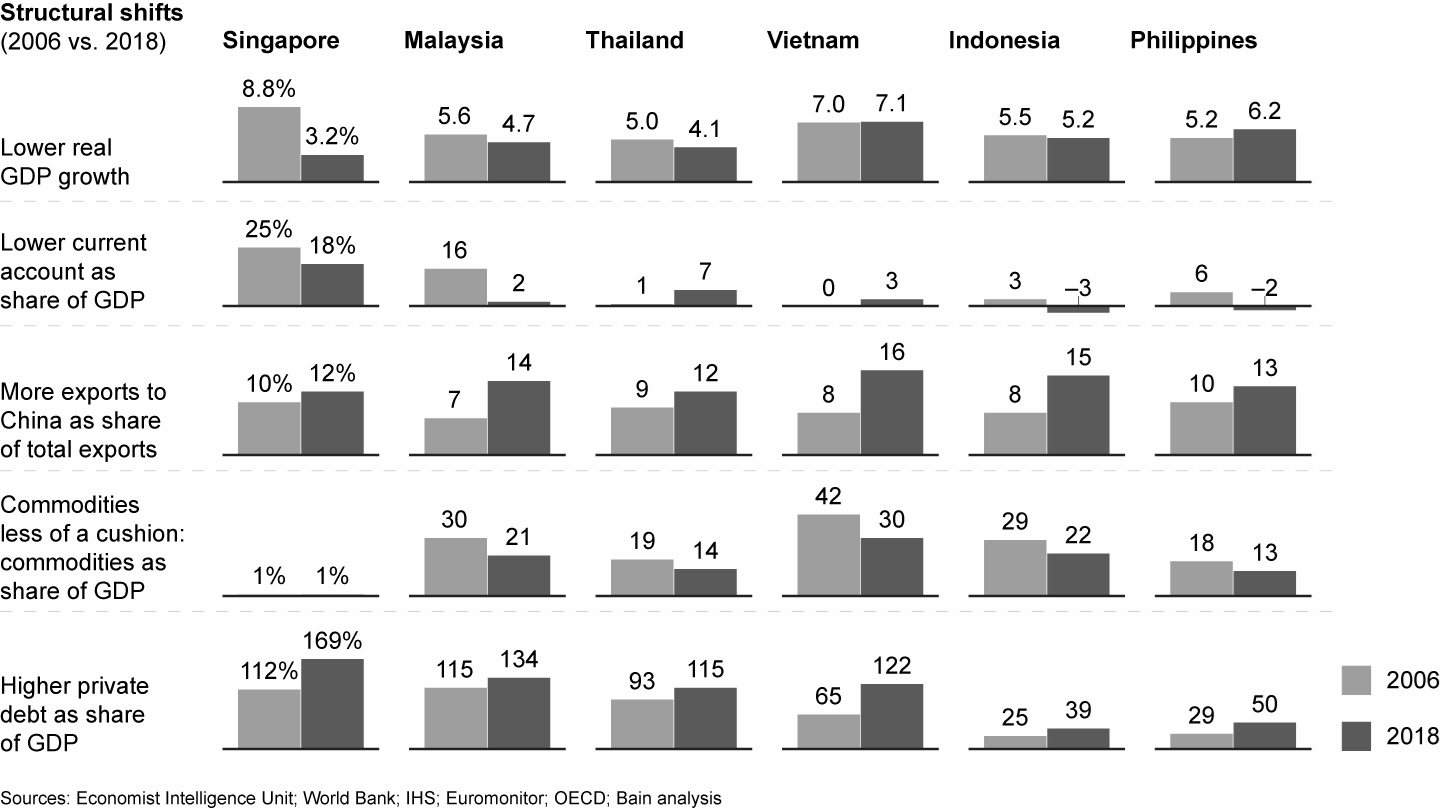
Yet companies across Southeast Asian countries and industries can take lessons from how winning companies behaved differently than others just prior to and during the last global recession. Our research reveals key moves by companies that outperformed peers in four areas: early attention to cost productivity, plus some combination of balance sheet discipline, aggressive commercial growth plays and proactive M&A. Let’s look at each in turn.
Focus on cost productivity without cutting muscle. We analyzed the cost productivity of 200 public companies in Southeast Asia. We defined cost productivity as earnings before interest, taxes, depreciation and amortization (EBITDA) growth less revenue growth—namely, the part of EBITDA growth attributable to cost rather than revenue. To be clear, this metric is not perfect in isolating cost issues from pricing or product mix issues, nor does it replace other standard metrics such as cost of goods sold or return on capital employed.
The strength of this cost productivity lens is its ability to produce insights about performance comparisons with direct competitors and companies in other industries. It also helps identify the companies and practices that succeed in improving efficiency and powering EBITDA year after year.
The findings are clear: Winners had a 29% CAGR in EBITDA, 5 points ahead of revenue CAGR, during the economic expansion of 2003 through 2007. In spite of their growth, these firms did not waver from their focus on cost efficiency. The losers had a 21% CAGR, with just 1 point coming from cost productivity (see Figure 6). The winners’ cost focus accelerated during the 2007 to 2009 slowdown, with cost productivity yielding a 10% CAGR on top of a 10% revenue CAGR, compared with negative 2% on top of 4%, respectively, for the losers. The cost productivity divergence continued across industries during the subsequent recovery.
Top performers excel on both revenue growth and cost productivity in good times and bad

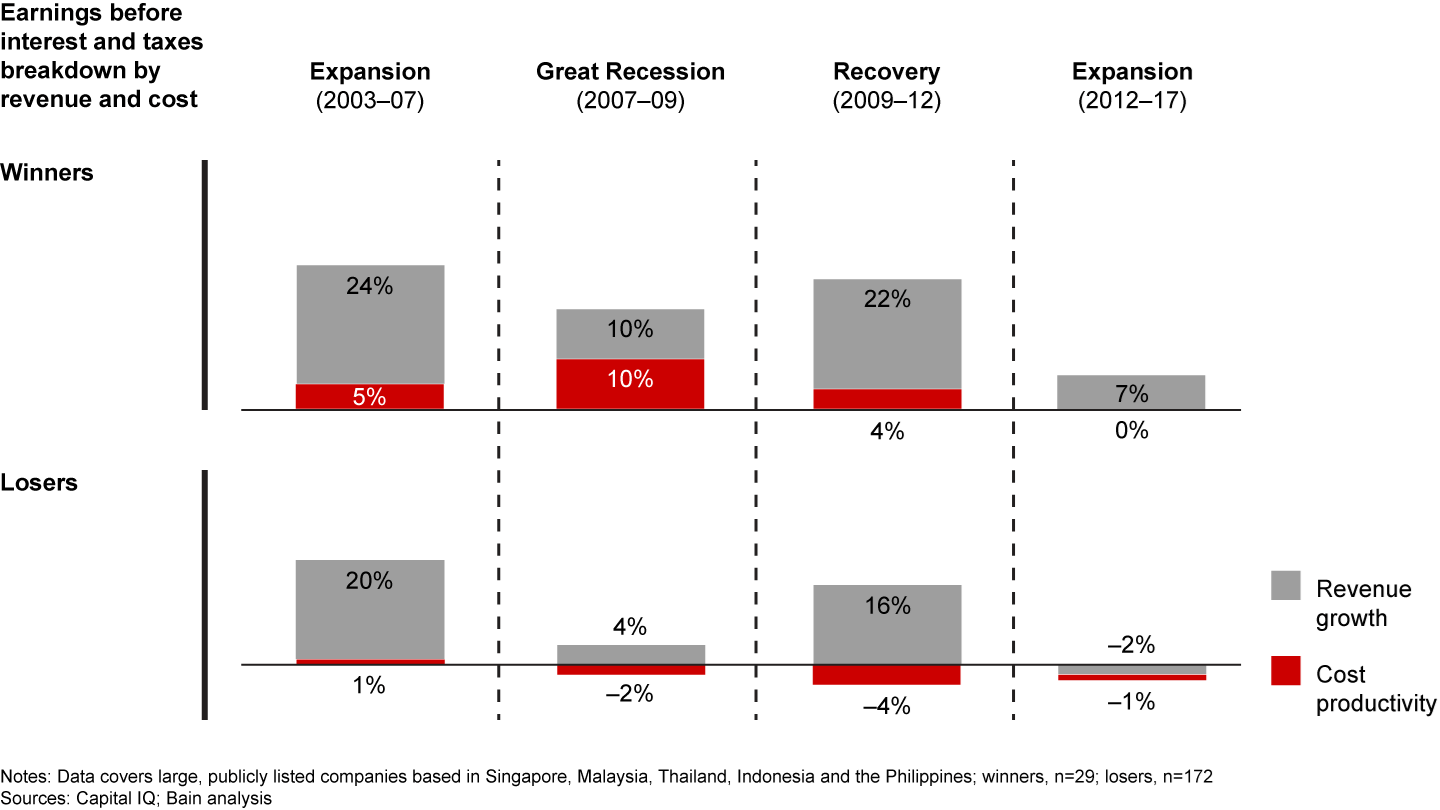
This trend does not involve cutting costs across the board, which would stall growth. Cost productivity champions take a different tack. They decide where they need to be best in class and where they can be “good enough” and low cost. They ratchet down spending on lower-value processes and reduce the volume and complexity of work. They view cost management as a way to refuel the growth engine for the next stage in the business cycle.
Put the financial house in order. Downturns often wreak havoc on balance sheets. The winners managed the balance sheet as strategically as they did profit and loss (P&L). They tightly managed cash, working capital and capex, all to create fuel to invest throughout the cycle. Many companies also divested noncore assets to invest further in the core business or explored new ownership models in typically capital-intensive industries.
Play offense by reinvesting selectively for commercial growth. Coming out of the last downturn, the strongest companies went on offense early while many of their peers focused on survival and waited for the cycle to clear. Successful growth companies used a few tactics to boost commercial growth.
Some invested substantially in R&D or in critical assets instead of dialing back. Others increased marketing while competitors cut back. They pointed sales teams to top priorities among accounts and prospects as determined by the account’s all-in profitability and potential lifetime value. They realigned distribution by rebalancing the mix of current and new locations or next-generation formats.
Pursue a proactive M&A pipeline. For the well positioned, the last downturn presented a window to use M&A to reshape the portfolio of businesses. Acquirers bought new product lines, customer segments or capabilities at lower prices. Others exited businesses that didn’t fit strategically with the company’s future—that is, after identifying legacy assets that no longer figured in the emerging business model.
To get a sense of how these moves played out on the ground, consider the experience of two companies that ranked among the winners: AirAsia and JG Summit Holdings.
How AirAsia doubled down
Malaysia-based AirAsia was able to grow revenue and maintain its EBIT margin from 2007 through 2012, more than doubling passenger volume. During the 2007 to 2009 period, the company managed a 69% CAGR in revenue growth, far exceeding the overall industry rate of 2.6%. The company’s success stemmed from several deliberate tactics.
At the highest level, AirAsia doubled down on its leadership position in a low-cost business model. It focused on keeping costs low without degrading service through tactics such as emphasizing online channels, which handled 80% of sales during this period; shifting to more fuel-efficient Airbus A320-200 aircraft, which in turn reduced operational complexity as staff had to service only one type of aircraft; and removing administrative fees to passengers.
AirAsia also continued to focus on balance sheet discipline. For instance, it boosted capital investment countercyclically, when the cost of capital was lower and its ability to negotiate was better, ordering 25 A320-200 jets from Airbus in 2007, on top of 150 orders in the previous two years. That made the airline the world’s largest customer for A320-200s, and it did not delay receipt when the global recession hit.
AirAsia reinvested in its core business. The airline tripled the marketing budget during the financial crisis and launched a high-profile “1 million free seats” campaign to build brand loyalty. It expanded through higher-priced, demand-resilient routes, such as Tiruchirappalli in India, an ancient city that attracts pilgrims, and increased daily low-cost options to otherwise expensive routes, such as Kuala Lumpur to Singapore.
These downturn-ready tactics, along with other moves, allowed AirAsia to improve its competitive position during and well beyond the downturn. And customers have embraced AirAsia: Based on a survey of nearly 22 million travelers, Skytrax recently named it the world’s best low-cost airline for the 11th consecutive year.
JG Summit strengthened each piece of its portfolio
JG Summit, a leading conglomerate based in the Philippines, is a more complicated story because the company is so diversified, but we can group its tactics in similar categories.
To start, JG Summit focused on cost productivity through operating measures in its various subsidiaries. For instance, food and beverage company Universal Robina restructured management and sales units and consolidated manufacturing operations in Shanghai in 2007. Robinsons Land consolidated other real estate subsidiaries in 2008 to reap economies of scale. Cebu Air passed on fuel surcharges to passengers, unbundled services and increased rates. JG Summit also increased its cash reserves by more than 20% from 2007 through 2009.
Turning to the balance sheet, JG Summit took a number of steps to put its financial house in order. To generate capital for growth, it issued new stock to the public for Universal Robina and Robinsons Land in 2006. To take advantage of lower costs of capital, it made several debt and equity investments: Robinsons Land issued fixed-rate notes in 2009, and United Industrial bought shares in 2008 when the price had fallen by roughly 40% since the boom period.
JG Summit went on offense for its core business along several fronts. For example, Universal Robina diversified more into beverages and also expanded heavily in Vietnam. Robinsons Land acquired prime property in Bonifacio Global City in 2007.
Finally, JG Summit used selective M&A to grow its market share. Universal Robina acquired General Milling’s Granny Goose brand and snacks line in 2008. In 2007, JGS Petrochemicals, previously a joint venture with Marubeni, became a wholly owned subsidiary of JG Summit, allowing the company to pursue different strategic alternatives. Using capital from several divestments, the company identified adjacent categories for diversification, such as Robinsons Bank buying the Royal Bank of Scotland-Philippines in 2010 to upgrade from a thrift to a commercial bank.
All of these moves bolstered JG Summit’s position, leading to steady growth during and after the last downturn. The conglomerate grew revenue 11% and nearly doubled its EBIT margin from 8% to 15% during the 2007 to 2009 period. But no company can rest on its laurels. In recent years, JG Summit, similar to other conglomerates in developing markets, has delivered a lower total shareholder return (TSR) relative to pure-play companies. JG Summit remains in the top quartile for TSR among Southeast Asian conglomerates and is on an upward trajectory, but it will need to exercise the same disciplines it practiced during the last downturn in order to continue to thrive.
Practical steps for companies to take now
Every company in Southeast Asia enters the next global downturn from a different starting point, so the right plan hinges first on knowing where the company stands in both its strategic and financial positions. Although specific actions will vary by industry and geographical exposure, all companies sort into one of four basic positions that will determine the shape of the program and additional strategies to pursue (see Figure 7). These strategies range from investing for leadership based on a superior strategic and financial position to readying a weak part of the portfolio for sale.
Taking advantage of a downturn starts with a realistic assessment of a company’s strategic and financial starting positions

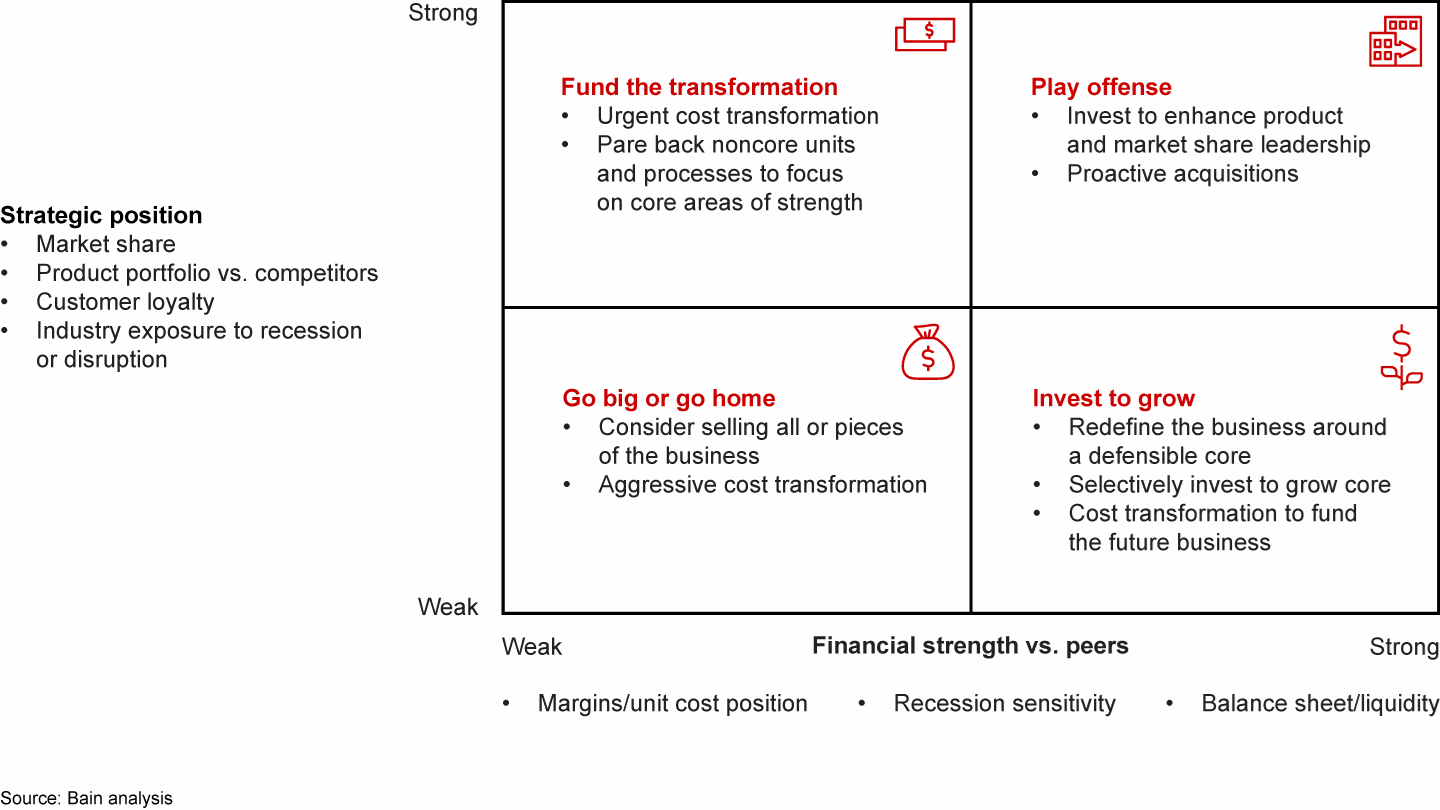
To raise the odds of success, management teams can map out a series of offensive moves that aim to create a stronger business throughout the downturn and beyond.
- Start with the end in mind. What do you want the company to look like at the end of the downturn and three years after? A “future back” approach that defines the desired future state helps you know exactly where to invest—that is, the customer segments to target, the value proposition, and the technologies and assets supporting the business. A clear plan lays out specifically how the business will outperform competitors throughout and beyond the downturn.
- Raise cost productivity now (and always). A smart program starts early and focuses on sustained changes, instead of cutting muscle or trimming across the board.
- Stress test the P&L and balance sheet. Model the 2019 to 2022 P&L, cash flow and balance sheet through turbulent scenarios—including flat or lower market growth, lower prices and higher unit economics—for your company and against your competitors.
- Identify M&A targets early. Map out a proactive M&A plan that includes add-on acquisitions, divesting noncore assets and potentially big moves with large-scale peers. That way, you can pull the trigger when the time is right, as opposed to reacting and missing the opportunity.
Virtually all senior executives in Southeast Asia agree that local economies will flatten or turn down in the near future. Astute leaders, though, realize the value of preparing for the turn now, even if their companies have not yet felt the pain and are currently focused on managing growth. If past patterns are any guide, their downturn-proof moves will allow them to steal a march on competitors that falter and drop to a trailing position from which they may not recover.
Thomas Olsen leads Bain & Company's Strategy and Corporate Finance practices in Asia-Pacific, and he is based in the firm’s Singapore office. Sharad Apte leads Bain’s Healthcare practice in Southeast Asia, and he is the firm’s Bangkok office head. Nader Elkhweet is a partner with Bain’s Consumer Products and Retail practices, and he is the firm’s Jakarta office head. Francesco Cigala leads the Performance Improvement practice in Southeast Asia, and he is the firm’s Kuala Lumpur office head.